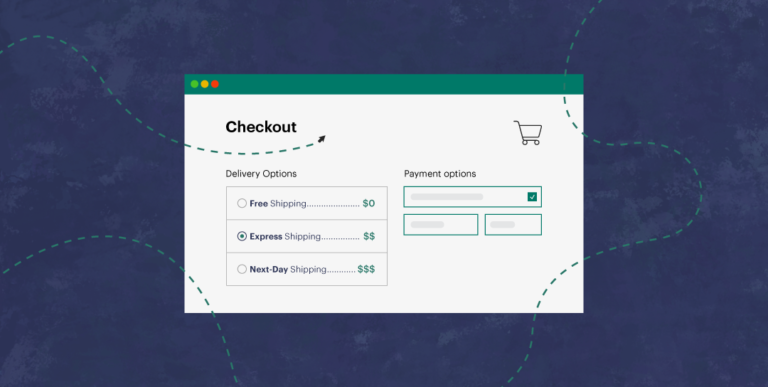How Do I Calculate Shipping Costs and Charge Customers?

Knowing what to charge customers requires you to calculate shipping costs and determine the best carrier services for each order. There are a few things that go into shipping costs and what to charge. These are some of the things to be aware of when shipping online orders.
How do I calculate shipping costs?
From weight, dimensions, destinations, additional surcharges, and more options, shipping costs have a lot of factors. There are very few flat rate shipping options. Let’s go over some of the most common things that influence shipping costs.
Weight
A package’s weight is a major deciding factor in a shipping carrier’s base rate. Typically, each new pound increases the shipping cost. While there are factors such as dimensions and shipping zones, it is usually weight that determines which shipping service to use.
Dimensions
Dimensions play a big part in shipping costs. Typically, a package’s dimensions don’t increase the rate to a new threshold. Rather, dimensions are more of a limiting factor—if you exceed a carrier’s maximum dimensions, it is subject to an additional handling surcharge.
Destinations and Shipping Zone
Shipping zones are what carriers use to determine the distance between the origin and destination addresses of a domestic package. This distance is ranked in levels of 1-9. If the distance is a 1, or local, this is the shortest distance. Meanwhile, 9 is the furthest distance—overseas territories. Keep in mind, though, that international rates are determined a bit differently, though.
Surcharges
Surcharges increase shipping costs for customers and merchants alike. Surcharges are more common with carriers that post-bill, such as FedEx and UPS. These generally include additional fees for things like extended area delivery surcharges (a home in a more remote location) or residential surcharges.
How UPS, FedEx, and USPS Treat Weight and Dimensions
USPS Maximum Dimensions and Weight
The USPS’ has a slightly smaller allowable maximum size than other carriers. Domestic pieces may not measure more than 108 inches in length and girth combined and 70 lbs in max weight. Oversized USPS parcels will have a $100 fee applied to them.
FedEx Maximum Dimensions and Weight
With FedEx Ground® and FedEx Home Delivery® Services, you can ship packages up to 150 lbs; up to 108″ in length, and 165″ in length plus girth. An oversized surcharge of $52.50 applies to all FedEx parcels exceeding these size and weight limits.
UPS Maximum Dimensions and Weight
UPS allows packages up to 150 lbs with a maximum size of 165 inches in length and girth combined. An oversize surcharge of between $95-$115 will be applied to all UPS parcels exceeding these weight and size limits.
Cubic Rates
Cubic rates help make smaller, heavier parcels more affordable. Cubic rates are determined by a formula. Highly discounted rates for high-volume shippers for packages under 20lbs that are no larger than .5 cubic feet.
Cubic Feet Formula
Length x Width x Height / 1728 = Cubic Feet
While ShipStation doesn’t offer full Cubic pricing, we do offer discounted cubic rates for any customer through our relationship with Stamps.com.
Dimensional Weight
Dimensional weight is the exact opposite of cubic rates. Instead of charging you less for small, heavy parcels. You get charged MORE for big, lightweight parcels. So, a can of chili and a pillow that have the same weight could have different shipping rates.
The Dimensional formula
| Carrier | Domestic Dimensional Formula |
| UPS | (L x W x H)/ 139 |
| FedEx | (L x W x H)/ 139 |
| USPS | (L x W x H)/ 166 |
How to Calculate USPS shipping cost
Calculating USPS shipping costs is generally more straightforward than UPS or FedEx. The rates don’t increase based on Saturday delivery or residential surcharges. Since USPS charges upon creation for a label, all fees are usually included in the initial cost.
How to Calculate FedEx shipping cost
FedEx has more surcharges and factors to consider than USPS. For instance, FedEx has surcharges that can increase the price by a substantial amount. Things like residential surcharges and fuel surcharges may not be fully calculated until after an item is delivered.
Shipping rates you’re quoted at the time of label creation may not accurately reflect the final shipping costs. For instance, the residential surcharge may not be applied when you use FedEx’s rate calculator. If your recipient is residential, use FedEx Home® delivery. This residential surcharge also allows for Saturday delivery at no extra cost. So the shipping cost you charge customers may need to be adjusted slightly.
How to Calculate UPS shipping cost
Similar to FedEx, UPS has additional shipping surcharges that increase the cost of a label from its base rate. However, if you want to avoid some of these surcharges and get more affordable UPS shipping rates, ShipStation’s integration with UPS offers cheaper shipping rates with fewer surcharges than you’d find with a standalone UPS account—which ShipStation also supports.
How To Charge For Shipping
Customers have eased up a bit on shipping timeframes and demanding free shipping. However, demand for clearly communicated shipping times and simple pricing structures has become stronger. For the most information about how customers prefer shipping, download ShipStation’s research guide that goes into detail about shipping expectations.
To save on shipping your parcels as well as everything else, sign up for ShipStation to see how cheap shipping can be.
How to Charge For Shipping on Etsy
Etsy makes charging shipping costs pretty easy. Since Etsy requires free shipping on orders over $35 for merchants participating in the free shipping guarantee, you may need to find cheap shipping options. Since customers are more likely to purchase from merchants offering free shipping, having an affordable shipping solution is key. Furthermore, you can inject some of the shipping costs into the item cost to increase cart conversions.
How to Charge For Shipping on Amazon
Amazon is among the most rigid places to sell on—particularly if you want to become a Prime seller or to get the featured offer. Furthermore, offering free shipping is essential to being Prime or featured. Free shipping is a tad easier to offer if you can inject some of the shipping costs into the item’s price. However, this can be risky as you don’t want to be costlier than the featured seller. Many sellers cite Amazon as being a great place to get the word out about their products. With their rigid packaging guidelines and customer-centric returns strategy, some sellers just use Amazon as a marketplace for their lower-cost items with more affordable shipping prices.
How to Charge For Shipping on eBay
eBay has a few shipping guidelines to be aware of. For instance, you MUST use a shipping service with tracking. You also can’t use a slower shipping method than what the customer selects. Apart from this, there aren’t many rules. Shipping costs can be determined with the Ebay rate calculator. You may also use ShipStation’s USPS postage calculator to get a good idea of the rates available.
How to Charge for Shipping on Your Website
If you have your own website on platforms like Wix.com, Shopify, or WooCommerce, it is usually simplest to adopt some of the more favorable shipping options from your marketplace platforms. We found that 78% of customers have become more willing to shop from a small retailer than they were before COVID-19. So, this is a good time to move off of a marketplace and open your own store. But, the important thing to keep in mind is that customers do have expectations of quick delivery. So, if you can ship out items within 24 hours, offer affordable shipping costs, and send shipping confirmation emails in a timely manner, you should be good! Let’s go over how to determine these shipping costs.
To start saving on shipping costs, sign up for a free ShipStation trial today!
How Much to Charge For Domestic Shipping
Domestic shipping is usually pretty straightforward. You’ll find the shipping services that work best for your different items and regions of the country. The problem with domestic shipping is knowing what to charge. There are a few options that work well. Some are better for your customers and some are better for the merchant.
Offer Flat-Fee Shipping
Flat-fee shipping doesn’t require you use USPS Flat Rate boxes. However, this could be a good option if your parcels are heavy as it is the same rate as long as a parcel is under 70 lbs. This is especially good considering FedEx and UPS tend to be more affordable over about 6 lbs.
Flat-rate shipping is a good idea because customers don’t like surprises. This is why places like Amazon are so popular. Everything is quick, efficient, and easy to understand. Offering flat rate shipping is a good idea on your own website because it allows you to appear organized and in control of your shipping volume. Having different shipping rates for different items may be a good way to protect your profit margins, but it is less likely to result in an order being placed. Using something like “shipping is $4.99 for items under $75.” is a good way to get cart conversions while also incentivizing them to reach a threshold for free shipping.
Why Charging Threshold Shipping Works
Threshold shipping is very common. It allows customers to get free shipping if they place an order above a certain cost. Generally, it’s just north of your average order total. This can be a way to get another item added to the cart. Advertising high-profit margin items that cost under about $20 can be an easy way to reduce surplus inventory as well as increase profits.
Customers Prefer Free Shipping
Obviously, free is king. If you can offer free shipping by injecting a little bit of the shipping cost into the item, do that. Our research study found that 56% of Americans expect free shipping in order to place an order. If you want to make these sales, you have to accept that your profit margin will narrow. Threshold shipping can be a way to get the best of both worlds, though.
How Much to Charge For International Shipping
International shipping is an entirely separate beast. It can be confusing, expensive, and an insufferably long ordeal to get international customers their orders. Free shipping is almost always off the table, even to nearby countries like Canada. Flat-fee shipping to certain countries is usually the best way to go as far as cart conversions go, but shipping fees can vary wildly from country to country. So it may be best to have rules set up to determine how much to add for shipping depending on the destination country. Shopify has a thorough tutorial on selling and shipping internationally that has plenty of good information. But let’s get into some of the finer points of shipping internationally that can become an expensive surprise for you and your customers.
How Customs and Taxes Raise Shipping Costs
Customs fees and import taxes can rack up quickly. And while it’s common for your customers to pay these import taxes, you may choose to pay them. And this can become a costly process. For instance, shipping to Europe has just become more expensive since VAT taxes apply to all international orders—not just those valued at over $22. Luckily, programs like the IOSS allow you to pay these fees instead of your customers for orders up to $150. Even if you charge customers based on these additional surcharges, it is easier than having to have them deal with it. Again, taxes and customs fees make international shipping very expensive. And the difficulties don’t end with it being more expensive. What happens if an item is rejected or undeliverable?
Return to Sender vs Treat as Abandoned
When an item can not make final delivery to an international customer, you’re left with the decision to just scrap the item or to have it shipped back to you. Remember, once an item clears customs, those charges may still need to be paid, even once they’re returned. This can cause the final shipping charges to be far higher than the item cost. At this point, it may just be easier to just treat the item as abandoned. These are shipping options that you can configure. But, it is important to remember that regardless of which option you choose, you should charge international customers accordingly.
How ShipStation Helps Reduce Shipping Costs
ShipStation is a great tool for understanding shipping costs. With all your orders laid out regardless of order source, with the ability to compare different services and choose carriers based on the cheapest shipping price and delivery time-frame, you can figure out how much your shipping costs as well as how much to charge.
Additionally, shipping costs include the amount of time it takes you and your team to fulfill an order. Luckily, ShipStation’s automation rules and user roles make shipping simple, automated, and avoids duplicate shipments. The leaner your processing time, the quicker your orders go out lets you work with a leaner, more efficient staff, pay less for shipping, charge your customers less—resulting in happier customers that give you better reviews and become repeat customers.


